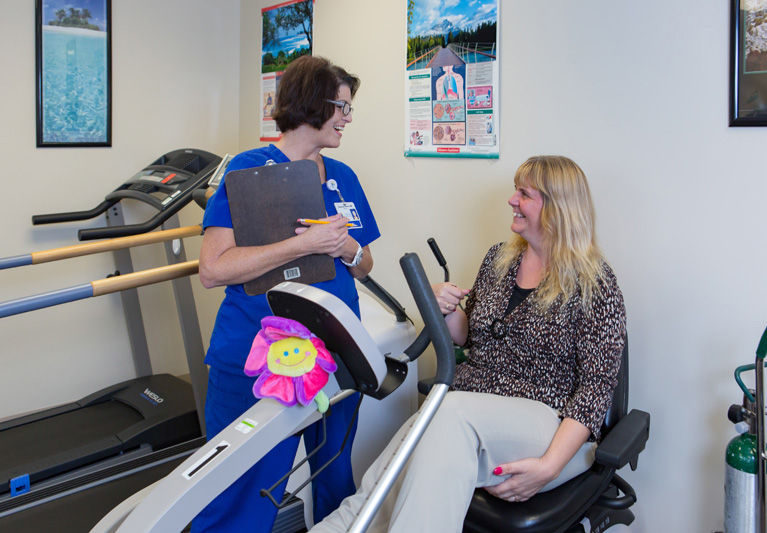
Pulmonary rehabilitation is a program of exercise, education and support designed to help people with serious lung problems learn to breathe better and to function at the highest level possible.
At Sebastian River Medical Center, Vanessa Srein, RN may technically have the title of “pulmonary rehab nurse,” but – at least to the casual observer – she is the undisputed queen of one small section of that healthcare facility.
Effervescent, energetic and inquisitive, Srein might just be the perfect antidote for people whose ability to breathe effortlessly has been hijacked by diseases. Those diseases can include chronic obstructive pulmonary disease or COPD, sarcoidosis, idiopathic pulmonary fibrosis and cystic fibrosis.
Srein runs a series of small, four-member classes three days each week for her pulmonary patients. She teaches breathing strategies and exercise training while also offering nutritional counseling and tips on energy-conserving techniques. That would be a daunting task for most people, but somehow Srein can’t help cracking jokes.
“I tell people rule number one is do not scare the nurse,” Srein deadpans, though it seems unlikely, given Srein’s years of training and experience, that anyone in rehab could scare this high-energy dynamo.
The National Institutes of Health says that pulmonary rehabilitation requires, “a long-term commitment from the patient and a team of health care providers,” and the Sebastian program is no exception to that rule.
Srein explains that a typical course of treatment consists of 36 weeks with three sessions each week.
The hard fact is that diseases like COPD, which Srein says is the number one condition her pulmonary patients are dealing with, are not curable.
COPD doesn’t just go away. The best anyone with COPD can hope for is to maximize his or her remaining lung capacity.
Still, the medical textbook Merck Manuals says, “Pulmonary rehabilitation programs may improve a patient’s quality of life by reducing shortness of breath, increasing exercise tolerance, promoting a sense of well-being and to a lesser extent, decreasing the number of hospitalizations” each patient might otherwise expect.
According to the COPD Foundation, “In order to qualify for pulmonary rehabilitation, a referral from a doctor and a spirometry test within the past year,” are required to show a patient’s eligibility for Medicare coverage.
Srein says, “We do a complete head to toe assessment,” for pulmonary rehab candidates. The patient’s current level of activity is assessed and a series of goals are set.
Throughout the program, participants’ heart rates, blood pressure and oxygen levels are watched closely using remote sensors. “We have a monitor on you,” Srein explains, “and we can see your heart rate so if something looks wrong we can stop you.”
“Our goal here,” Srein continues, “is to help patients increase their lung capacity and I teach them things such as pursed-lip breathing and diaphragmatic breathing.”
The Cleveland Clinic defines pursed-lip breathing as, “one of the simplest ways to control shortness of breath. It provides a quick and easy way to slow your pace of breathing, making each breath more effective.”
It’s a simple technique.
First the patient relaxes his or her neck and shoulder muscles. The patient then inhales
slowly through the nose for two counts, keeping the mouth closed. Next, they pucker or “purse” the lips and slowly and gently exhale through those pursed lips while counting to four.
Diaphragmatic breathing can be a little trickier to master and requires practice. The diaphragm is the main muscle used in normal breathing but for COPD patients the diaphragm doesn’t work as well as it once did. Re-training the diaphragm, “to take over more work of breathing can help,” according to the COPD Foundation.
Placing one hand on the chest and the other on the belly, the patient inhales through the nose for about two seconds. The belly should move more than the chest. As the patient exhales, he or she presses on the belly, which pushes up on the diaphragm to help get air out of the lungs.
Will Srein’s exercises and breathing techniques completely eliminate the pulmonary problems of her patients? No. But the small class sizes help create what Srein sees as a cordial, cooperative atmosphere in which patients can maximize their lung capacity and gain appreciably more productive lives.
“It is,” Srein says smiling, “a quality of life thing.”
When her 36-week classes end, this queen of pulmonary rehab will cue up Edward Elgar’s “Pomp and Circumstance” graduation march, crack a few more jokes and send her graduates on their way breathing at least a bit more easily.



